Models of communication

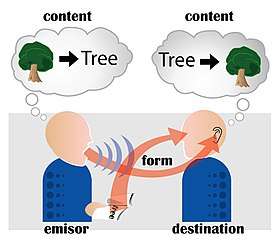
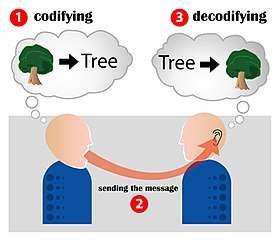

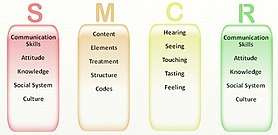
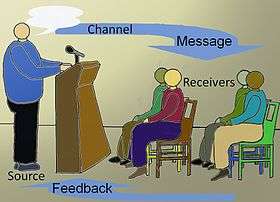
Models of communication are conceptual models used to explain the human communication process. The first major model for communication was developed in 1948 by Claude Elwood Shannon and published with an introduction by Warren Weaver for Bell Laboratories.[1] Following the basic concept, communication is the process of sending and receiving messages or transferring information from one part (sender) to another (receiver).[2]
In 1960, David Berlo expanded the linear transmission model [3] with the Sender-Message-Channel-Receiver(SMCR) Model of Communication. [4] Later, Wilbur Schramm introduced a model that identified multiple variables in communication which includes the transmitter, encoding, media, decoding, and receiver. [5]
Shannon-Weaver Model
Elwood Shannon and Warren Weaver were engineers that worked for Bell Telephone Labs in the United States. Their goal was to make sure that the telephone cables and radio waves were working at the maximum efficiency. Therefore, they developed the Shannon-Weaver model which had an intention to expand a mathematical theory of communication.[6] The Shannon–Weaver model was developed in 1949 which is referred as the 'mother of all models'.[7] The model is well accepted as a main initial model for Communication Studies which has grown since then.[8]
As well, the Shannon-Weaver model was designed to mirror the functioning of radio and telephone technology. Their initial model consisted of four primary parts: sender, message, channel, and receiver. The sender was the part of a telephone a person speaks into, the channel was the telephone itself, and the receiver was the part of the phone through which one can hear the person on the other end of the line. Shannon and Weaver also recognized that there may often be static or background sounds that interfere with the process of the other partner in a telephone conversation; they referred to this as noise. Certain types of background sounds can also indicate the absence of a signal.[6]
The original model of Shannon and Weaver has five elements: information source, transmitter, channel, receiver, and destination. To illustrate the process of the communication the first step is the information source where the information is stored. Next, in order to send the information, the message is encoded into signals, so it can travel to its destination. After the message is encoded, it goes through the channel which the signals are adapted for the transmission. In addition, the channel carried the noise course which is any interference that might happen to lead to the signal receive a different information from the source. After the channel, the message arrives in the receiver step where the message reconstruct (decode) from the signal. Finally, the message arrives at the destination.[9]
In a simple model, often referred to as the transmission model or standard view of communication, information or content (e.g. a message in natural language) is sent in some form (as spoken language) from an emissor/ sender/ encoder to a destination/ receiver/ decoder. According to this common communication-related conception, communication is viewed as a means of sending and receiving information. The strengths of this model are its simplicity, generality, and quantifiability. The mathematicians Claude Shannon and Warren Weaver structured this model on the basis of the following elements:
- An information source, which produces a message.
- A transmitter, which encodes the message into signals
- A channel, for which signals are adapted for transmission
- A receiver, which reconstructs the encoded message from a sequence of received signals and decodes it.
- An information destination, where the message arrives.
Shannon and Weaver argued that this concept entails three levels of problems for communication:
- The technical problem: how accurately can the message be transmitted?
- The semantic problem: how precisely is the meaning 'conveyed'?
- The effectiveness problem: how effectively does the received meaning affect behavior?
Daniel Chandler criticizes the transmission model in the following terms:[10]
- It assumes that communicators are isolated individuals.
- It makes no allowance for differing purposes.
- It makes no allowance for differing interpretations.
- It makes no allowance for unequal power relationships.
Berlo
In 1960, David Berlo expanded Shannon and Weaver's 1949 linear model of communication and created the Sender-Message-Channel-Receiver (SMCR) Model of Communication.[11] The SMCR Model of Communication separated the model into clear parts and has been expanded upon by other scholars.
The Berlo's communication process is a simple application for communication of person-to-person which include communication source, encoder, message, channel, decoder, and communication receiver. [12] In addition, David Berlo presented some factors that influence the communication process between two people. The factors include communication skills, awareness level, social system, cultural system, and attitude.[13]
The Berlo's Model of Communication process starts at the source. This is the part where determine the communication skills, attitude, knowledge, social system, and culture of the people involved in the communication. After the message is developed which is elements in a set of symbols. [13] Then the encoder step beginning. The encoder process is where the motor skills take place by speaking or writing. [12] The message goes through the channel which carries the message by hearing, seeing, touching, smelling, or tasting.[3] Then the decoder process takes place. In this process, the receiver interpreter the message with her or him sensory skills. Finally, the communication receiver gets the whole message understood.[12]
Schramm
Communication is usually described along a few major dimensions: Message (what type of things are communicated), source / emissor / sender / encoder (by whom), form (in which form), channel (through which medium), destination / receiver / target / decoder (to whom), and Receiver. Wilbur Schramm (1954) also indicated that we should also examine the impact that a message has (both desired and undesired) on the target of the message.[14] Between parties, communication includes acts that confer knowledge and experiences, give advice and commands, and ask questions. These acts may take many forms, in one of the various manners of communication. The form depends on the abilities of the group communicating. Together, communication content and form make messages that are sent towards a destination. The target can be oneself, another person or being, another entity (such as a corporation or group of beings).
Communication can be seen as processes of information transmission governed by three levels of semiotic rules:
- Syntactic (formal properties of signs and symbols),
- Pragmatic (concerned with the relations between signs/expressions and their users) and
- Semantic (study of relationships between signs and symbols and what they represent).
Therefore, communication is social interaction where at least two interacting agents share a common set of signs and a common set of semiotic rules. This commonly held rule in some sense ignores autocommunication, including intrapersonal communication via diaries or self-talk, both secondary phenomena that followed the primary acquisition of communicative competences within social interactions.
Barnlund
In light of these weaknesses, Barnlund (1970) proposed a transactional model of communication.[15] The basic premise of the transactional model of communication is that individuals are simultaneously engaging in the sending and receiving of messages.
In a slightly more complex form, a sender and a receiver are linked reciprocally. This second attitude of communication, referred to as the constitutive model or constructionist view, focuses on how an individual communicates as the determining factor of the way the message will be interpreted. Communication is viewed as a conduit; a passage in which information travels from one individual to another and this information becomes separate from the communication itself. A particular instance of communication is called a speech act. The sender's personal filters and the receiver's personal filters may vary depending upon different regional traditions, cultures, or gender; which may alter the intended meaning of message contents. In the presence of "noise" on the transmission channel (air, in this case), reception and decoding of content may be faulty, and thus the speech act may not achieve the desired effect. One problem with this encode-transmit-receive-decode model is that the processes of encoding and decoding imply that the sender and receiver each possess something that functions as a [code-book], and that these two code books are, at the very least, similar if not identical. Although something like code books is implied by the model, they are nowhere represented in the model, which creates many conceptual difficulties.
Theories of co-regulation describe communication as a creative and dynamic continuous process, rather than a discrete exchange of information. Canadian media scholar Harold Innis had the theory that people use different types of media to communicate and which one they choose to use will offer different possibilities for the shape and durability of society.[16] His famous example of this is using ancient Egypt and looking at the ways they built themselves out of media with very different properties stone and papyrus. Papyrus is what he called 'Space Binding'. it made possible the transmission of written orders across space, empires and enables the waging of distant military campaigns and colonial administration. The other is stone and 'Time Binding', through the construction of temples and the pyramids can sustain their authority generation to generation, through this media they can change and shape communication in their society.[16]
Constructionist
There is an additional working definition of communication to consider that authors like Richard A. Lanham (2003) and as far back as Erving Goffman (1959) have highlighted. This is a progression from Lasswell's attempt to define human communication through to this century and revolutionized into the constructionist model. Constructionists believe that the process of communication is in itself the only messages that exist. The packaging can not be separated from the social and historical context from which it arose, therefore the substance to look at in communication theory is style for Richard Lanham and the performance of self for Erving Goffman.
Lanham chose to view communication as the rival to the over encompassing use of CBS model (which pursued to further the transmission model). CBS model argues that clarity, brevity, and sincerity are the only purpose to prose discourse, therefore communication. Lanham wrote: "If words matter too, if the whole range of human motive is seen as animating prose discourse, then rhetoric analysis leads us to the essential questions about prose style" (Lanham 10). This is saying that rhetoric and style are fundamentally important; they are not errors to what we actually intend to transmit. The process which we construct and deconstruct meaning deserves analysis.
Erving Goffman sees the performance of self as the most important frame to understand communication. Goffman wrote: "What does seem to be required of the individual is that he learn enough pieces of expression to be able to 'fill in' and manage, more or less, any part that he is likely to be given" (Goffman 73), highlighting the significance of expression.
The truth in both cases is the articulation of the message and the package as one. The construction of the message from social and historical context is the seed as is the pre-existing message is for the transmission model. Therefore, any look into communication theory should include the possibilities drafted by such great scholars as Richard A. Lanham and Goffman that style and performance is the whole process. lun
Communication stands so deeply rooted in human behaviors and the structures of society that scholars have difficulty thinking of it while excluding social or behavioral events. Because communication theory remains a relatively young field of inquiry and integrates itself with other disciplines such as philosophy, psychology, and sociology, one probably cannot yet expect a consensus conceptualization of communication across disciplines.
Communication Model Terms as provided by Rothwell (11-15):
- Noise; interference with effective transmission and reception of a message.
- For example;
- physical noise or external noise which are environmental distractions such as poorly heated rooms, startling sounds, appearances of things, music playing some where else, and someone talking really loudly near you.
- physiological noise are biological influences that distract you from communicating competently such as sweaty palms, pounding heart, butterfly in the stomach, induced by speech anxiety, or feeling sick, exhausted at work, the ringing noise in your ear, being really hungry, and if you have a runny nose or a cough.
- psychological noise are the preconception bias and assumptions such as thinking someone who speaks like a valley girl is dumb, or someone from a foreign country can’t speak English well so you speak loudly and slowly to them.
- semantic noise are word choices that are confusing and distracting such as using the word tri-syllabic instead of three syllables.
- For example;
- Sender; the initiator and encoder of a message
- Receiver; the one that receives the message (the listener) and the decoder of a message
- Decode; translates the sender's spoken idea/message into something the receiver understands by using their knowledge of language from personal experience.
- Encode; puts the idea into spoken language while putting their own meaning into the word/message.
- Channel; the medium through which the message travels such as through oral communication (radio, television, phone, in person) or written communication (letters, email, text messages)
- Feedback; the receiver's verbal and nonverbal responses to a message such as a nod for understanding (nonverbal), a raised eyebrow for being confused (nonverbal), or asking a question to clarify the message (verbal).
- Message; the verbal and nonverbal components of language that is sent to the receiver by the sender which conveys an idea.
Humans act toward people or things on the basis of the meanings they assign to those people or things. -"Language is the source of meaning". -Meaning arises out of the social interaction people have with each other.
-Meaning is not inherent in objects but it is negotiated through the use of language, hence the term symbolic interactionism. As human beings, we have the ability to name things. Symbols, including names, are arbitrary signs. By talking with others, we ascribe meaning to words and develop a universe of discourse A symbol is a stimulus that has a learned/shared meaning and a value for people Significant symbols can be nonverbal as well as linguistic.
-Negative responses can consequently reduce a person to nothing. -Our expectations evoke responses that confirm what we originally anticipated, resulting in a self-fulfilling prophecy.
Linear
This is a one-way model to communicate with others. It consists of the sender encoding a message and channeling it to the receiver in the presence of noise. In this model there is no feedback or response which may allow for a continuous exchange of information (F.N.S. Palma, 1993).
The linear model was first introduced by Shannon & Weaver in 1949. In the linear communication model, the message travels one direction from the start point to the endpoint. In other words, once the sender sends the message to the receiver the communication process ends. Many communications online use the linear communication model. For example, when you send an email, post a blog, or share something on social media. However, the linear model does not explain many other forms of communication including face-to-face conversation.[17]
Interactive/convergence
It is two linear models stacked on top of each other. The sender channels a message to the receiver and the receiver then becomes the sender and channels a message to the original sender. This model has added feedback, indicating that communication is not a one way but a two way process. It also has "field of experience" which includes our cultural background, ethnicity geographic location, extent of travel, and general personal experiences accumulated over the course of your lifetime. Draw backs – there is feedback but it is not simultaneous.
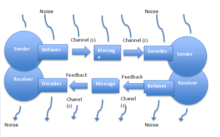
- For example, – instant messaging. The sender sends an IM to the receiver, then the original sender has to wait for the IM from the original receiver to react. Or a question/answer session where you just ask a question then you get an answer.
Communication theory framework
Communication theory can be seen from one of the following viewpoints:
- Mechanistic: This view considers communication as a perfect transaction of a message from the sender to the receiver. (as seen in the diagram above)
- Psychological: This view considers communication as the act of sending a message to a receiver, and the feelings and thoughts of the receiver upon interpreting the message.
- Social Constructionist (Symbolic Interactionist): This view considers communication to be the product of the interactants sharing and creating meaning. The Constructionist View can also be defined as, how you say something determines what the message is. The Constructionist View assumes that "truth" and "ideas" are constructed or invented through the social process of communication. Robert T. Craig saw the Constructionist View or the constitutive view as it's called in his article, as "…an ongoing process that symbolically forms and re-forms our personal identities." (Craig, 125). The other view of communication, the Transmission Model, sees communication as robotic and computer-like. The Transmission Model sees communication as a way of sending or receiving messages and the perfection of that. But, the Constructionist View sees communications as, "…in human life, info does not behave as simply as bits in an electronic stream. In human life, information flow is far more like an electric current running from one landmine to another" (Lanham, 7). The Constructionist View is a more realistic view of communication because it involves the interacting of human beings and the free sharing of thoughts and ideas. Daniel Chandler looks to prove that the Transmission Model is a lesser way of communicating by saying "The transmission model is not merely a gross over-simplification but a dangerously misleading representation of the nature of human communication" (Chandler, 2). Humans do not communicate simply as computers or robots so that's why it's essential to truly understand the Constructionist View of Communication well. We do not simply send facts and data to one another, but we take facts and data and they acquire meaning through the process of communication, or through interaction with others.
- Systemic: This view considers communication to be the new messages created via "through-put", or what happens as the message is being interpreted and re-interpreted as it travels through people.
- Critical: This view considers communication as a source of power and oppression of individuals and social groups.[18]
Inspection of a particular theory on this level will provide a framework on the nature of communication as seen within the confines of that theory.
Theories can also be studied and organized according to the ontological, epistemological, and axiological framework imposed by the theorist.
Ontology
Ontology essentially poses the question of what, exactly, the theorist is examining. One must consider the very nature of reality. The answer usually falls in one of three realms depending on whether the theorist sees the phenomena through the lens of a realist, nominalist, or social constructionist. Realist perspective views the world objectively, believing that there is a world outside of our own experience and cognitions. Nominalists see the world subjectively, claiming that everything outside of one's cognitions is simply names and labels. Social constructionists straddle the fence between objective and subjective reality, claiming that reality is what we create together.
Epistemology
Epistemology is an examination of the approaches and beliefs which inform particular modes of study of phenomena and domains of expertise. In positivist approaches to epistemology, objective knowledge is seen as the result of the empirical observation and perceptual experience. In the history of science, empirical evidence collected by way of pragmatic-calculation and the scientific method is believed to be the most likely to reflect truth in the findings. Such approaches are meant to predict a phenomenon. Subjective theory holds that understanding is based on situated knowledge, typically found using interpretative methodology such as ethnography and also interviews. Subjective theories are typically developed to explain or understand phenomena in the social world.
Axiology
Axiology is concerned with how values inform research and theory development.[19] Most communication theory is guided by one of three axiological approaches. The first approach recognizes that values will influence theorists' interests but suggests that those values must be set aside once actual research begins. Outside replication of research findings is particularly important in this approach to prevent individual researchers' values from contaminating their findings and interpretations.[20] The second approach rejects the idea that values can be eliminated from any stage of theory development. Within this approach, theorists do not try to divorce their values from inquiry. Instead, they remain mindful of their values so that they understand how those values contextualize, influence or skew their findings.[21] The third approach not only rejects the idea that values can be separated from research and theory, but rejects the idea that they should be separated. This approach is often adopted by critical theorists who believe that the role of communication theory is to identify oppression and produce social change. In this axiological approach, theorists embrace their values and work to reproduce those values in their research and theory development.[22]
Some realms of communication and their theories
- message production: Constructivist Theory, Action Assembly Theory
- message processing: Elaboration Likelihood Model, Inoculation theory
- discourse and interaction: Speech Acts Theory, Coordinated Management of Meaning
- developing relationships: Uncertainty Reduction Theory, Social Penetration Theory, Predicted Outcome Value Theory
- ongoing relationships: Relational Systems Theory, Relational Dialectics
- organizational: Structuration Theory, Unobtrusive and Concertive Control Theory
- small group: Functional Theory, Symbolic Convergence Theory
- media processing and effects: Social Cognitive Theory, Uses and Gratifications Theory
- media and society: Agenda Setting, Information deficit model, Spiral of silence, Symbolic Convergence Theory
- culture: Speech Codes Theory, Face-saving Theory
- making social worlds: Coordinated Management of Meaning, Symbolic Interactionism
- science communication: Gateway Belief Model
Notes
- ↑ Shannon, C. E., & Weaver, W. (1949). The mathematical theory of communication. Urbana, Illinois: University of Illinois Press
- ↑ Craig 1999.
- 1 2 Berlo, D. K. (1960). The process of communication; an introduction to theory and practice. New York: Holt, Rinehart and Winston. Claude E Shannon, W. W. (1949)
- ↑ Schulz, Peter. Cobley, Paul. (2013). Theories and Models of Communication. Berlin: De Gruyter Mouton. 2013.
- ↑ Qing-Lan Chen, Chiou-Shuei Wei, Mei-Yao Huang and Chiu-Chi Wei. (2013) A model for project communication medium evaluation and selection.
- 1 2 Chandler Daniel, The Transmission Model of Communication. http://transcriptions-2008.english.ucsb.edu/archive/courses/warner/english197/Schedule_files/Chandler/Transmission.model_files/trans.htm (1994)
- ↑ Erik Hollnagel, David D. Woods. Joint Cognitive Systems: Foundations of Cognitive Systems Engineering. CRC Press. 2005
- ↑ Fiske, John. Introduction to Communication Studies. London: Routledge (Chapter 1, 'Communication Theory' is a good introduction to this topic). (1982)
- ↑
- ↑ Chandler, Daniel (1994). The Transmission Model of Communication. University of Western Australia. Retrieved 11.06.2011. Check date values in:
|accessdate=(help) - ↑ Berlo, D. K. (1960). The process of communication. New York, New York: Holt, Rinehart, & Winston.
- 1 2 3 Ann, Bette. Berlo's Communication Process Model as Applied to the Behavioral Theories of Maslow, Herzberg, and McGrego. Stead Source: The Academy of Management Journal, Vol. 15, No. 3 (Sep., 1972), pp. 389-394 Published by: Academy of Management Stable URL: https://www.jstor.org/stable/254868
- 1 2 Sluková, Petra Zia. Studies of Information and Knowledge Management in he European Context: No. 5 Communication of Information Reg. No: CZ.1.07/2.2.00/07.0284 OP: Education for Competitiveness Support area. 2.2 University Education Realization: VŠB-Technical University of Ostrava, Faculty of Economics, separate unit: Business Academy and HPS Valašské Meziříčí
- ↑ Schramm, W. (1954). How communication works. In W. Schramm (Ed.), The process and effects of communication (pp. 3-26). Urbana, Illinois: University of Illinois Press.
- ↑ Barnlund, D. C. (2008). A transactional model of communication. In. C. D. Mortensen (Eds.), Communication theory (2nd ed., pp47-57). New Brunswick, New Jersey: Transaction.
- 1 2 Wark, McKenzie (1997). The Virtual Republic. Allen & Unwin, St Leonards.
- ↑ McCornack, Steven. Ortiz, Joseph. Choice & Connections: An Introduction to Communication. (2017)
- ↑ Littlejohn, S.W. and Foss, K.A. (2008). Theories of human communication, 9th edition. Belmont, CA: Thomson Wadsworth.
- ↑ Miller 2005.
- ↑ Miller 2005, p. 30.
- ↑ Miller 2005, pp. 30–31.
- ↑ Miller 2005, p. 31.
References
- Craig, Robert T. (1999). "Communication Theory as a Field". Communication Theory. 9 (2): 119–161. doi:10.1111/j.1468-2885.1999.tb00355.x. ISSN 1050-3293.
- Miller, Katherine (2005). Communication Theories: Perspectives, Processes, and Contexts (2nd ed.). McGraw-Hill Higher Education. ISBN 0-07-293794-7.